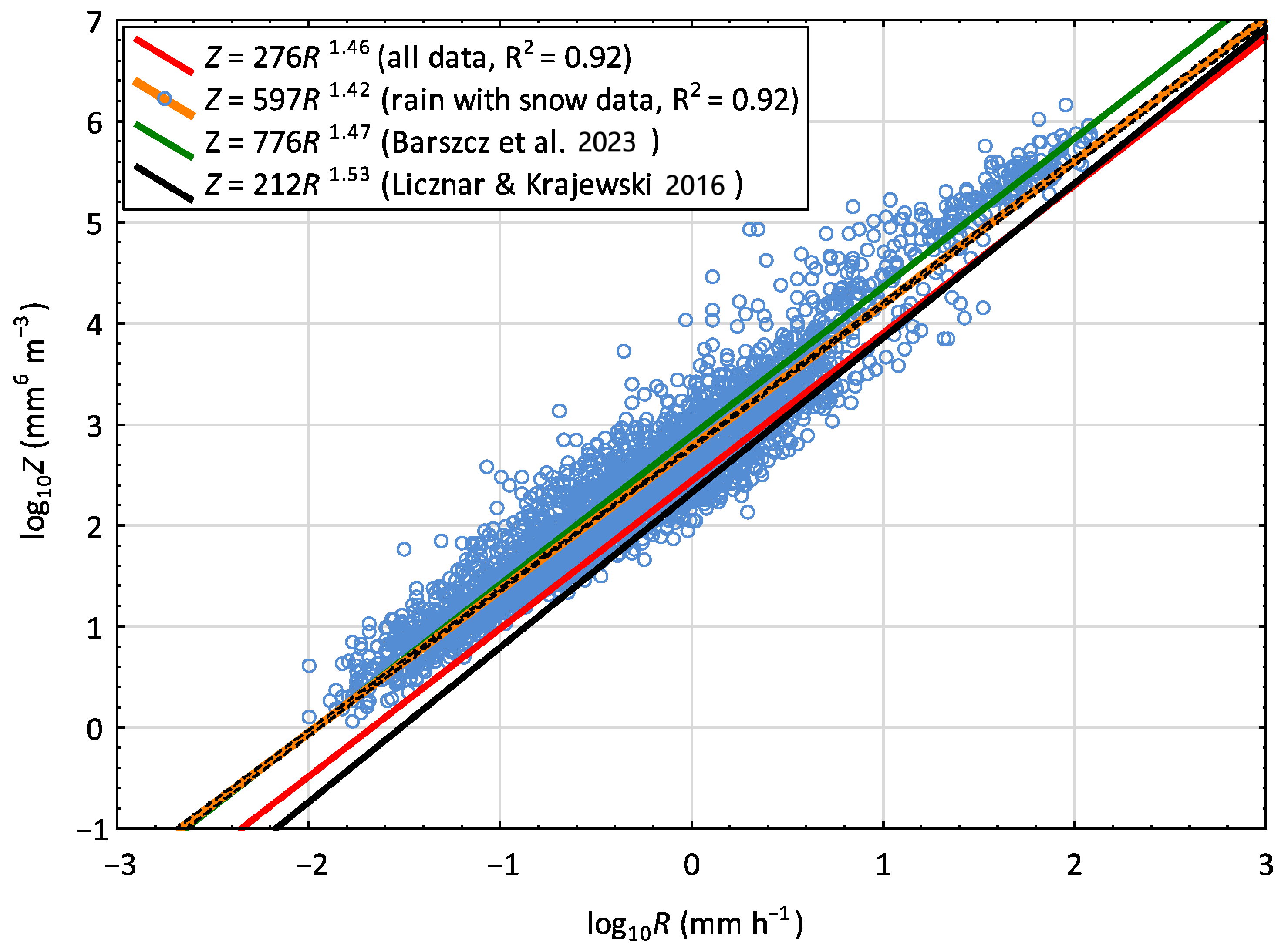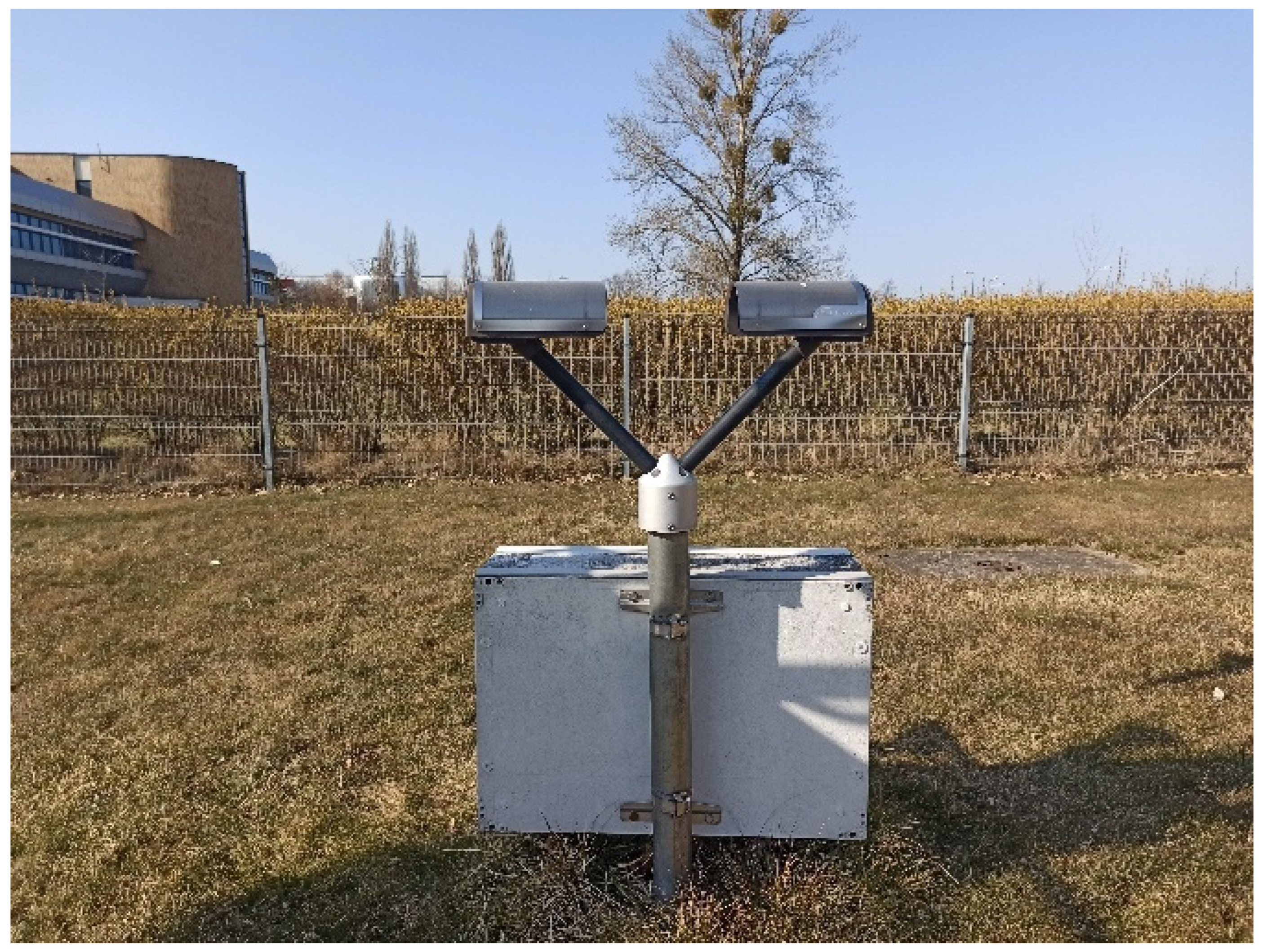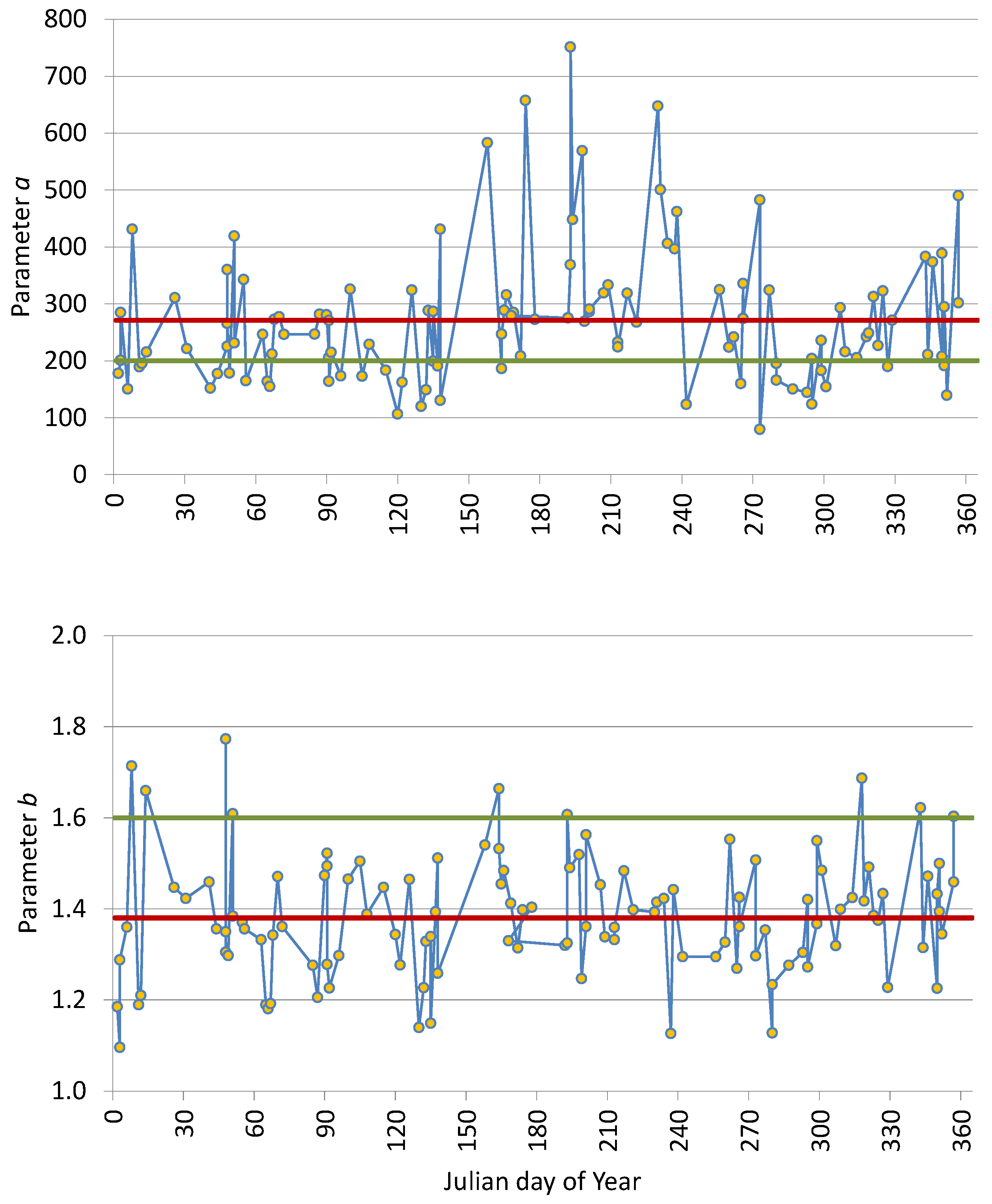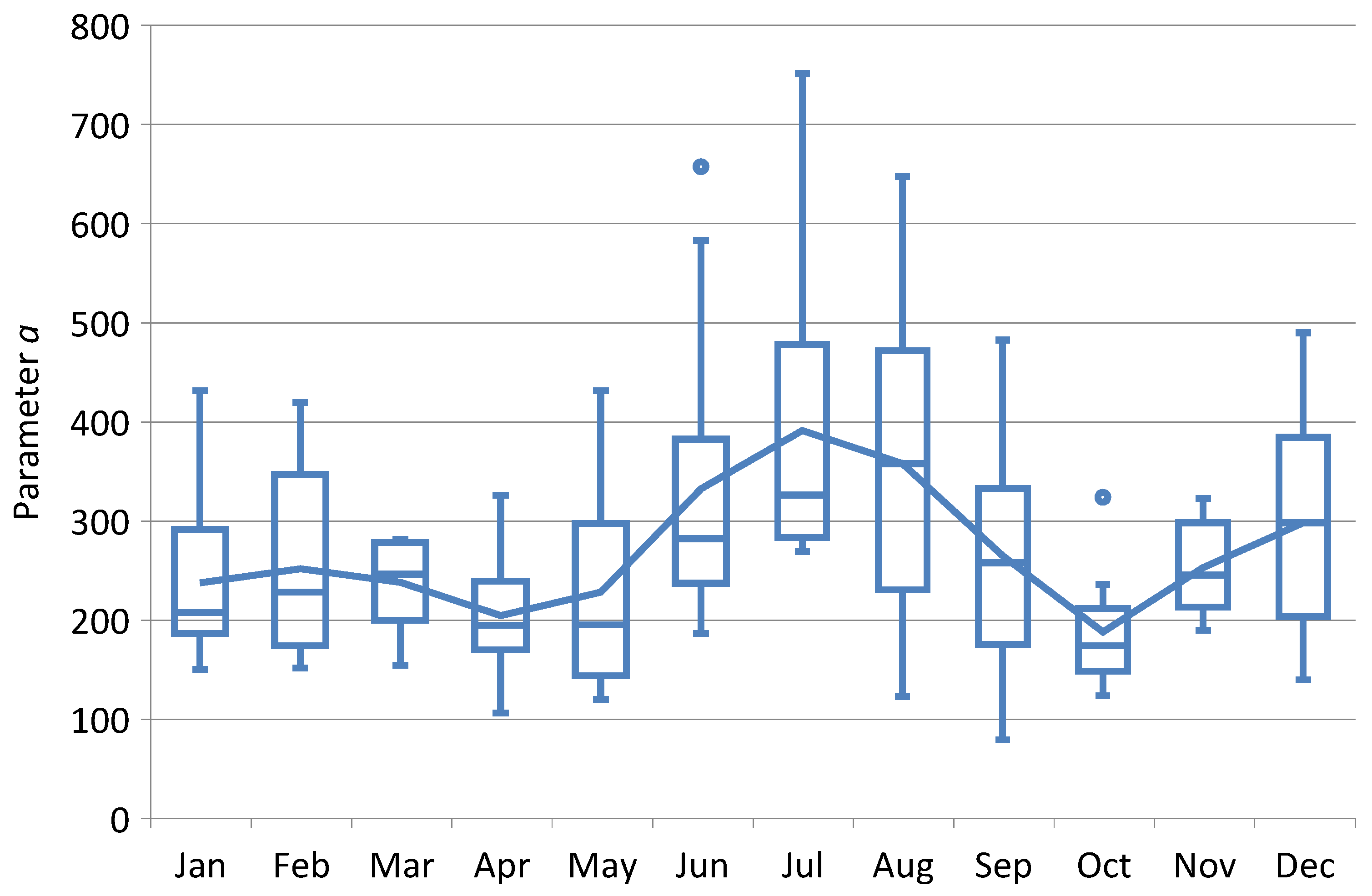Z–R Relationships for Different Precipitation Types and Events from Parsivel Disdrometer Data in Warsaw, Poland
Abstract
1. Introduction
2. Materials and Methods
2.1. Disdrometer Data Processing and Characterization
- Z—radar reflectivity (mm6 m−3);
- R—rain rate (mm h−1);
- N(D)—number of drops (hydrometeors) of diameter D (mm) within a given size and fall velocity class;
- —fall velocity of hydrometeors (m s−1).
2.2. Z–R Relationship
3. Results and Discussion
3.1. Z–R Relationships for Different Precipitation Types



3.2. Z–R Relationships for Individual Precipitation Events
4. Conclusions
- In a study including rain events only, a Z–R relationship of the form Z = 265R1.48 was obtained, with parameters very similar to those of the relationship derived for the entire dataset, Z = 276R1.46. The slight differences in their parameter values are due to the predominance of rain-type events (88.9%) in the dataset. The estimated values of the parameters a and b showed relatively small deviations from the corresponding values in the classical function for convective-type rainfall, Z = 300R1.4 [55]. However, the value of the parameter a obtained in this study for Warsaw differed from the Z–R relationship determined by Marshall and Palmer [60], Z = 200R1.6, which is used to convert radar reflectivity into total precipitation in, among others, the Polish POLRAD radar system. It should be noted that the Marshall–Palmer relationship is above all recommended for stratiform precipitation. The data used in the present study included rainfall of varying character, both stratiform and convective, which led to an averaging of Z–R relationship parameters. In the case of the parameter a, a significant deviation was also observed compared to the results obtained in the Warsaw area by other researchers: a = 170 [41] and a = 191 [9]. However, the data used in those studies covered relatively shorter observation periods.
- The values of the parameter a in the Z–R relationship for the other two types of precipitation, a = 597 for sleet (rain with snow) and a = 348 for snow, were significantly higher than the value determined for rain data alone. Moreover, they differed significantly from the corresponding values of the parameter a reported in previous studies conducted in the Warsaw area [9,42]. It should be noted that the observational data for the listed precipitation types together represented only 11.1% of the entire measurement dataset. Therefore, further research in this area is warranted, which will be conducted using a more extensive dataset.
- The differences observed in this study between the values of the parameter a for data representing three distinct groups of precipitation types indicate the need to include Z–R relationships tailored to specific precipitation types in the radar data processing procedure.
- The values of the parameter a in the Z–R relationship were characterized by high variability for the 118 individual events, ranging from 80 to 751. The mean and median values of this parameter were 271 and 247, respectively. In contrast, the values of the parameter b represented a more predictable range of values, from 1.10 to 1.77 (with a median of b = 1.37).
- The highest unit values of the parameter a, as well as its highest mean and median values, were recorded in June, July, and August. The occurrence of these maximum statistical values in the summer months is as expected, as this period is particularly associated with convective rainfall. The presented results for the parameter a highlight the need for further research into its temporal variability under different meteorological conditions, such as those associated with the occurrence of stratiform and convective precipitation.
- A moderate correlation (the correlation coefficient, R = 0.46) was found between the unit values of the parameter a in the Z–R relationship and the mean reflectivity for 118 individual rainfall events.
Author Contributions
Funding
Data Availability Statement
Conflicts of Interest
References
- Xie, X.; Xiao, X.; He, J.; Garfias, P.S.; Li, T.; Yu, X.; Gu, S.; Guo, Y. In situ observations of rain rate and precipitation microphysics over the coastal area of south China: Perspectives for satellite validation. J. Hydrometeorol. 2024, 25, 1045–1059. [Google Scholar] [CrossRef]
- Atencia, A.; Mediero, L.; Llasat, M.C.; Garrote, L. Effect of radar rainfall time resolution on the predictive capability of distributed hydrologic model. Hydrol. Earth Syst. Sci. 2011, 15, 3809–3827. [Google Scholar] [CrossRef]
- Thorndahl, S.; Einfalt, T.; Willems, P.; Nielsen, J.E.; Veldhuis, M.-C.; Arnbjerg-Nielsce, K.; Rasmussen, M.R.; Molnar, P. Weather radar rainfall data in urban hydrology. Hydrol. Earth Syst. Sci. 2017, 21, 1359–1380. [Google Scholar] [CrossRef]
- Johannsen, L.L.; Zambon, N.; Strauss, P.; Dostal, T.; Neumann, M.; Zumr, D.; Cochrane, T.A.; Blöschl, G.; Klik, A. Comparison of three types of laser optical disdrometers under natural rainfall conditions. Hydrol. Sci. J. 2020, 65, 524–535. [Google Scholar] [CrossRef]
- Gualco, L.F.; Campozano, L.; Maisincho, L.; Robaina, L.; Muñoz, L.; Ruiz-Hernández, J.C.; Villacís, M.; Condom, T. Corrections of Precipitation Particle Size Distribution Measured by a Parsivel OTT2 Disdrometer under Windy Conditions in the Antisana Massif, Ecuador. Water 2021, 13, 2576. [Google Scholar] [CrossRef]
- Ro, Y.; Chang, K.-H.; Hwang, H.; Kim, M.; Cha, J.-W.; Lee, C. Comparative study of rainfall measurement by optical disdrometer, tipping-bucket rain gauge, and weighing precipitation gauge. Nat. Hazards 2024, 120, 2829–2845. [Google Scholar] [CrossRef]
- Seela, B.K.; Janapati, J.; Lin, P.-L.; Lan, C.H.; Huang, M.-Q. Evaluation of GPM DPR rain parameters with north Taiwan disdrometers. J. Hydrometeorol. 2024, 25, 47–64. [Google Scholar] [CrossRef]
- Moszkowicz, S.; Tuszyńska, I. Meteorologia Radarowa. Podręcznik Użytkownika Informacji Radarowej IMGW [Radar Meteorology. IMGW Radar Information USER Manual]; Instytut Meteorologii i Gospodarki Wodnej: Warszawa, Poland, 2006. (In Polish) [Google Scholar]
- Licznar, P.; Krajewski, W.F. Precipitation Type Specific Radar Reflectivity-rain Rate Relationship for Warsaw, Poland. Acta Geophys. 2016, 64, 1840–1857. [Google Scholar] [CrossRef]
- Chumchean, S.; Sharma, A.; Seed, A. Radar rainfall error variance and its impact on radar rainfall calibration. Phys. Chem. Earth 2003, 28, 27–39. [Google Scholar] [CrossRef]
- Lee, G.W.; Zawadzki, I. Radar calibration by gauge, disdrometer, and polarimetry: Theoretical limit caused by the variability of drop size distribution and application to fast scanning operational radar data. J. Hydrol. 2006, 328, 83–97. [Google Scholar] [CrossRef]
- Guyot, A.; Pudashine, J.; Protat, A.; Uijlenhoet, R.; Pauwels, V.R.N.; Seed, A.; Walker, J.P. Effect of disdrometer type on rain drop size distribution characterization: A new dataset for Southeastern Australia. Hydrol. Earth Syst. Sci. 2019, 23, 4737–4761. [Google Scholar] [CrossRef]
- Zeng, Y.; Yang, L.; Zhang, Z.; Tong, Z.; Li, J.; Liu, F.; Zhang, J.; Jiang, Y. Characteristics of Clouds and raindrop size distribution in Xinjiang, using cloud radar datasets and a disdrometer. Atmosphere 2020, 11, 1382. [Google Scholar] [CrossRef]
- Rosenfeld, D.; Ulbrich, C.W. Cloud microphysical properties, processes, and rain opportunities. Meteorol. Monogr. 2023, 30, 237–258. [Google Scholar] [CrossRef]
- Friedrich, K.; Higgins, S.; Masters, F.J.; Lopez, C.R. Articulating and stationary PARSIVEL disdrometer measurements in conditions with strong winds and heavy rainfall. J. Atmos. Ocean. Technol. 2013, 30, 2063–2080. [Google Scholar] [CrossRef]
- Conti, F.L.; Francipane, A.; Pumo, D.; Noto, L.V. Exploring single polarization X-band weather radar potentials for local meteorological and hydrological applications. J. Hydrol. 2015, 531, 508–522. [Google Scholar] [CrossRef]
- Baltas, E.A.; Panagos, D.S.; Mimikou, M.A. An approach for the Estimation of Hydrometeorological Variables Towars the Determination of Z–R Coefficients. Environ. Process. 2015, 2, 751–759. [Google Scholar] [CrossRef]
- Adirosi, E.; Roberto, N.; Montopoli, M.; Gorgucci, E.; Baldini, L. Influence of disdrometer type on weather radar algorithms from measured DSD: Application to Italian Climatology. Atmosphere 2018, 9, 360. [Google Scholar] [CrossRef]
- Angulo-Martínez, M.; Beguería, S.; Latorre, B.; Fernández-raga, M. Comparison of precipitation measurement by OTT Parsivel2 and Thies LPM optical disdrometers. Hydrol. Earth Syst. Sci. 2018, 22, 2811–2837. [Google Scholar] [CrossRef]
- Chen, P.; Wang, P.; Li, Z.; Yang, Y.; Jia, Y.; Yang, M.; Peng, J.; Li, H. Raindrop size distribution characteristics of heavy precipitation events based on a PWS100 disdrometer in the Alpine Mountains, Eastern Tianshan, China. Remote Sens. 2023, 15, 5068. [Google Scholar] [CrossRef]
- Xiao, W.; Zhang, Y.; Zheng, H.; Wu, Z.; Xie, Y.; Huang, Y. Microphysical characteristics of precipitation for four types of typical weather systems on Hainan Island. Remote Sens. 2024, 16, 4144. [Google Scholar] [CrossRef]
- Jameson, A.R.; Larsen, M.L.; Kostinski, A.B. Disdrometer network observations of finescale spatial-temporal clustering in rain. J. Atmos. Sci. 2015, 72, 1648–1666. [Google Scholar] [CrossRef]
- Gires, A.; Tchiguirinskaia, I.; Schertzer, D. Multifractal comparison of the outputs of two optical disdrometers. Hydrol. Sci. J. 2016, 61, 1641–1651. [Google Scholar] [CrossRef]
- Bournas, A.; Baltas, E. Determination of the Z–R Relationship through Spatial Analysis of X-Band Weather Radar and Rain Gauge Data. Hydrology 2022, 9, 137. [Google Scholar] [CrossRef]
- Ji, L.; Chen, H.; Li, L.; Chen, B.; Xiao, X.; Chen, M.; Zhang, G. Raindrop size distribution and rain characteristics observed by a Parsivel disdrometer in Beijing, Northern China. Remote Sens. 2019, 11, 1479. [Google Scholar] [CrossRef]
- Gatidis, C.; Schleiss, M.; Unal, C. A new power-law model for μ– Λ relationships in convective and stratiform rainfall. Atmos. Meas. Tech. 2024, 17, 235–245. [Google Scholar] [CrossRef]
- Peinó, E.; Bech, J.; Polls, F.; Udina, M.; Petracca, M.; Adirosi, E.; Gonzalez, S.; Boudevillain, B. Validation of GPM DPR rainfall and drop size distribution using disdrometer observations in the western mediterranean. Remote Sens. 2024, 16, 2594. [Google Scholar] [CrossRef]
- Schleiss, M. Number- and size-controlled rainfall regimes in the Netherlands: Physical reality or statistical mirage? Atmos. Meas. Tech. 2024, 17, 4789–4802. [Google Scholar] [CrossRef]
- Tang, Y.-S.; Chang, P.-L.; Chang, W.-Y.; Zhang, J.; Tang, L.; Lin, P.-F.; Chen, C.-R. A localized quantitative precipitation estimation for S-Band polarimetric radar in Taiwan. J. Hydrometeorol. 2024, 25, 1697–1712. [Google Scholar] [CrossRef]
- Bédard-Therrien, A.; Anctil, F.; Thériault, J.M.; Chalifour, O.; Payette, F.; Vidal, A.; Nadeau, D.F. Laveraging a radar-based disdrometer network to develop a probabilistic precipitation phase model in eastern Canada. Hydrol. Earth Syst. Sci. 2025, 29, 1135–1158. [Google Scholar] [CrossRef]
- Pickering, B.S.; Neely, R.R.; Harrison, D. The disdrometer verification network (DiVeN): A UK network of laser precipitation instruments. Atmos. Meas. Tech. 2019, 12, 5845–5861. [Google Scholar] [CrossRef]
- Angeloni, S.; Adirosi, E.; Sapienza, F.; Giannetti, F.; Francini, F. I wielu innych Enhanced estimation of rainfall from opportunistic microwave satellite signals. IEEE Trans. Geosci. Remote Sens. 2024, 62, 4101312. [Google Scholar] [CrossRef]
- Dunkerley, D. Recording rainfall intensity: Has an optimum method been found? Water 2023, 15, 3383. [Google Scholar] [CrossRef]
- Wang, X.; Shi, S.; Zhu, L.; Nie, Y.; Lai, G. Traditional and Novel methods of rainfall observation and measurement: A review. J. Hydrometeorol. 2023, 24, 2153–2176. [Google Scholar] [CrossRef]
- Licznar, P. Wstępne wyniki porównawczych testów polowych elektronicznego deszczomierza wagowego OTT Pluvio2 i disdrometru laserowego Parsivel [Preliminary results of comparative field test of the OTT Pluvio2 electronic weighing rain gauge and the Parsivel laser disdrometer]. Instal 2009, 7/8, 43–50. (In Polish) [Google Scholar]
- Szewrański, S. Rozbryzg Jako Forma Erozji Wodnej Gleb Lessowych [Splash as a Form of Water Erosion of Loess Soils]; Monografie 78; Wydawnictwo Uniwersytetu Przyrodniczego we Wrocławiu: Wrocław, Poland, 2009. (In Polish) [Google Scholar]
- Kamińska, J.; Machowczyk, A.; Szewrański, S. Zmienność parametrów rozkładu gamma wielkości kropel deszczu naturalnego dla różnych intensywności opadu [The variation of drop size gamma distribution parameters for different natural rainfall intensity]. Woda-Sr.-Obsz. Wiej. 2010, 10, 95–102. [Google Scholar]
- Burszta-Adamiak, E. Analysis of Stormwater Retention on Green Roofs. Arch. Environ. Prot. 2012, 38, 3–13. [Google Scholar] [CrossRef]
- Biniak-Pieróg, M.; Biel, G.; Szulczewski, W.; Żyromski, A. Evaluation of methods of comparative analysis of sums of atmospheric precipitation measured with the classical method and with a contact-less laser rain gauge. Ann. Wars. Univ. Life Sci.–SGGW Land Reclam. 2015, 47, 371–382. [Google Scholar] [CrossRef]
- Biniak-Pieróg, M. Monitoring of Atmospheric Precipitation and Soil Moisture as Basis for the Estimation of Effective Supply of Soil Profile with Water; Monografie 207; Wydawnictwo Uniwersytetu Przyrodniczego: Wrocław, Poland, 2017. [Google Scholar]
- Licznar, P.; Siekanowicz-Grochowina, K. Wykorzystanie disdrometru laserowego do kalibracji obrazów pochodzących z radarów opadowych na przykładzie Warszawy [The use of laser disdrometer for calibration of images from precipitation radars on the example of Warsaw]. Ochr. Sr. 2015, 37, 11–16. [Google Scholar]
- Barszcz, M.; Stańczyk, T.; Brandyk, A. Zależności między wartościami odbiciowości i intensywności opadów z disdrometru laserowego–dla radarowego szacowania wielkości opadów [The Z–R relationships for different types of precipitation as a tool for radar-based precipitation estimation]. Przegląd Geogr. 2023, 95, 149–162. (In Polish) [Google Scholar] [CrossRef]
- Barszcz, M. Zmienność zależności Z–R w okresach miesięcznych–dla zwiększenia dokładności szacowania wielkości opadów za pomocą radarów meteorologicznych [Variability of the Z–R relationship in monthly periods–to increase the accuracy of estimating the amount of precipitation using meteorological radars]. Przegląd Geogr. 2024, 96, 447–458. (In Polish) [Google Scholar] [CrossRef]
- Krajewski, W.F.; Kruger, A.; Caracciolo, C.; Golé, P.; Barthes, L.; Creutin, J.-D.; Delahaye, J.-Y.; Nikolopoulos, E.I.; Ogden, F.; Vinson, J.-P. DEVEX-Disdrometer Evaluation Experiment: Basic results and implications for hydrologic studies. Adv. Water Resour. 2006, 29, 311–325. [Google Scholar] [CrossRef]
- Tokay, A.; Wolff, D.B.; Petersen, W.A. Evaluation of the new version of the laser-optical disdrometer, OTT Parsivel2. J. Atmos. Ocean. Technol. 2014, 31, 1276–1288. [Google Scholar] [CrossRef]
- Raupach, T.H.; Berne, A. Correction of raindrop size distribution measured by Parsivel disdrometer, using a two-dimensional video disdrometer as a reference. Atmos. Meas. Tech. 2015, 8, 343–365. [Google Scholar] [CrossRef]
- Park, S.-G.; Kim, H.-L.; Ham, Y.-W.; Jung, S.-H. Comparative evaluation of the OTT PARSIVEL using a collocated two-dimensional video disdrometer. J. Atmos. Ocean. Technol. 2017, 34, 2059–2082. [Google Scholar] [CrossRef]
- Jwa, M.; Jin, H.-G.; Lee, J.; Moon, S.; Baik, J.-J. Characteristics of Raindrop Size Distribution in Seoul, South Korea According to Rain and Weather Types. Asia-Pac. J. Atmos. Sci. 2020, 57, 605–617. [Google Scholar] [CrossRef]
- Adirosi, E.; Porcù, F.; Montopoli, M.; Baldini, L.; Bracci, A.; Capozii, V.; Annella, C.; Budillon, G.; Bucchignani, E.; Zollo, A.L.; et al. Database of the Italian disdrometer network. Earth Syst. Sci. Data 2023, 15, 2417–2429. [Google Scholar] [CrossRef]
- Marshall, J.S.; Langille, R.C.; Palmer, W.M.K. Measurement of rainfall by radar. J. Meteorol. 1947, 4, 186–192. [Google Scholar] [CrossRef]
- Peleg, N.; Marra, F.; Fatichi, S.; Paschalis, A.; Molnar, P.; Burlando, P. Spatial variability of extreme rainfall at radar subpixel scale. J. Hydrol. 2018, 556, 922–933. [Google Scholar] [CrossRef]
- Moriasi, D.N.; Arnold, J.G.; Van Liew, M.W.; Bingner, R.L.; Harmel, R.D.; Veith, T.L. Model evaluation guidelines for systematic quantification of accuracy in watershed simulations. Trans. ASABE 2007, 50, 885–900. [Google Scholar] [CrossRef]
- Caracciolo, C.; Porcu, F.; Prodi, F. Precipitation classification at mid-latitudes in terms of drop size distribution parameters. Adv. Geosci. 2008, 16, 11–17. [Google Scholar] [CrossRef]
- Uijlenhoet, R.; Steiner, M.; Smith, J.A. Variability of raindrop size distributions in a squall line and implications for radar rainfall estimation. J. Hydrometeorol. 2003, 4, 43–61. [Google Scholar] [CrossRef]
- Hunter, S. WSR-88D radar rainfall estimation: Capabilities, limitations, and potential improvements. Natl. Weather Dig. 1996, 20, 26–36. [Google Scholar]
- Fulton, R.A.; Breidenbach, J.P.; Seo, D.-J.; Miller, D.A.; O’Bannon, T. The WSR-88D rainfall algorithm. Weather. Forecast. 1997, 13, 377–395. [Google Scholar] [CrossRef]
- Delrieu, G.; Bonnifait, L.; Kirstetter, P.-E.; Boudevillain, B. Dependence of radar quantitative precipitation estimation error on the rain intensity in the Cévennes region, France. Hydrol. Sci. J. 2014, 59, 1308–1319. [Google Scholar] [CrossRef]
- Amengual, A. Hydrometeorological analysis of the 12 and 13 September 2019 widespread flash flooding in eastern Spain. Nat. Hazards Earth Syst. Sci. 2022, 22, 1159–1179. [Google Scholar] [CrossRef]
- Jiang, Y.; Yang, L.; Zeng, Y.; Tong, Z.; Li, J.; Liu, F.; Zhang, J.; Liu, J. Comparison of summer raindrop size distribution characteristics in the western and central Tianshan Mountains of China. Meteorol. Appl. 2022, 29, e2067. [Google Scholar] [CrossRef]
- Marshall, J.S.; Palmer, W.M.K. The distribution of raindrops with size. J. Meteorol. 1948, 5, 165–166. [Google Scholar] [CrossRef]
- Gunn, K.L.S.; Marshall, J.S. The distribution with size of aggregate snowflakes. J. Meteorol. 1958, 15, 452–461. [Google Scholar] [CrossRef]
- Uijlenhoet, R.; Sempere Torres, D. Measurement and parameterization of rainfall microstructure. J. Hydrol. 2006, 328, 1–7. [Google Scholar] [CrossRef]
- Villarini, G.; Krajewski, W.F. Review of the different sources of uncertainty in single polarization radar-based estimates of rainfall. Surv. Geophys. 2010, 31, 107–129. [Google Scholar] [CrossRef]




| NWS Code | Precipitation Types |
|---|---|
| L−, L, L+ | Rain |
| RL−, RL+ | |
| R−, R, R+ | |
| RLS−, RLS+ | Sleet (rain with snow) |
| SP | |
| S−, S, S+ | Snow |
| Data Subsets —Precipitation Types | Number of Z–R Data Pairs | Precipitation Intensity R (mm h−1) | Precipitation Reflectivity Z (dBZ) | ||||
|---|---|---|---|---|---|---|---|
| Min. | Max. | Mean | Min. | Max. | Mean | ||
| All data | 161,594 | 0.01 | 153.52 | 1.27 | −10.00 | 61.83 | 17.25 |
| Rain | 143,629 | 0.01 | 153.52 | 1.30 | −10.00 | 60.25 | 17.29 |
| Sleet (rain with snow) | 3091 | 0.01 | 121.87 | 3.37 | 0.55 | 61.72 | 23.89 |
| Snow | 14,874 | 0.01 | 56.45 | 0.58 | −8.13 | 61.83 | 15.50 |
| Data Subsets —Precipitation Types | Parameters of the Z–R Relationship | RMSE log10Z | R2 | |||
|---|---|---|---|---|---|---|
| a | b | a (95% CI) | b (95% CI) | |||
| All data | 276.31 | 1.463 | 275.14–277.49 | 1.461–1.465 | 0.32 | 0.92 |
| Rain | 265.22 | 1.477 | 264.11–266.33 | 1.475–1.479 | 0.30 | 0.93 |
| Sleet (rain with snow) | 597.31 | 1.415 | 581.15–613.92 | 1.400–1.430 | 0.32 | 0.92 |
| Snow | 347.78 | 1.380 | 340.60–355.11 | 1.371–1.389 | 0.39 | 0.86 |
| Month | Number of Events | Parameter a | Parameter b | ||||||
|---|---|---|---|---|---|---|---|---|---|
| Min | Max | Median | Mean | Min | Max | Median | Mean | ||
| January | 10 | 150.55 | 431.30 | 208.05 | 237.87 | 1.10 | 1.71 | 1.32 | 1.36 |
| February | 10 | 151.91 | 419.42 | 228.47 | 251.87 | 1.30 | 1.77 | 1.36 | 1.43 |
| March | 10 | 154.96 | 281.66 | 246.65 | 238.40 | 1.18 | 1.47 | 1.30 | 1.30 |
| April | 10 | 106.44 | 325.94 | 194.79 | 204.75 | 1.23 | 1.52 | 1.42 | 1.40 |
| May | 10 | 120.10 | 431.34 | 195.23 | 228.40 | 1.14 | 1.51 | 1.31 | 1.31 |
| June | 10 | 186.55 | 657.25 | 282.11 | 332.45 | 1.31 | 1.66 | 1.45 | 1.45 |
| July | 10 | 269.39 | 751.22 | 326.37 | 391.18 | 1.25 | 1.61 | 1.41 | 1.42 |
| August | 10 | 123.51 | 647.53 | 357.95 | 358.14 | 1.13 | 1.48 | 1.40 | 1.37 |
| September | 8 | 79.64 | 482.68 | 257.96 | 265.36 | 1.27 | 1.55 | 1.34 | 1.38 |
| October | 10 | 124.16 | 324.36 | 174.64 | 188.28 | 1.13 | 1.55 | 1.33 | 1.34 |
| November | 10 | 189.96 | 322.62 | 245.72 | 253.04 | 1.23 | 1.69 | 1.41 | 1.42 |
| December | 10 | 139.81 | 489.93 | 298.31 | 298.26 | 1.23 | 1.62 | 1.44 | 1.44 |
| minimum | 79.64 | 281.66 | 174.64 | 188.28 | 1.10 | 1.47 | 1.30 | 1.30 | |
| maximum | 269.39 | 751.22 | 357.95 | 391.18 | 1.31 | 1.77 | 1.45 | 1.45 | |
| median | 145.18 | 431.32 | 246.19 | 252.46 | 1.23 | 1.58 | 1.38 | 1.39 | |
| mean | 149.75 | 463.77 | 251.35 | 270.70 | 1.21 | 1.60 | 1.37 | 1.39 | |
Disclaimer/Publisher’s Note: The statements, opinions and data contained in all publications are solely those of the individual author(s) and contributor(s) and not of MDPI and/or the editor(s). MDPI and/or the editor(s) disclaim responsibility for any injury to people or property resulting from any ideas, methods, instructions or products referred to in the content. |
© 2025 by the authors. Licensee MDPI, Basel, Switzerland. This article is an open access article distributed under the terms and conditions of the Creative Commons Attribution (CC BY) license (https://creativecommons.org/licenses/by/4.0/).
Share and Cite
Barszcz, M.P.; Kaznowska, E. Z–R Relationships for Different Precipitation Types and Events from Parsivel Disdrometer Data in Warsaw, Poland. Remote Sens. 2025, 17, 2271. https://doi.org/10.3390/rs17132271
Barszcz MP, Kaznowska E. Z–R Relationships for Different Precipitation Types and Events from Parsivel Disdrometer Data in Warsaw, Poland. Remote Sensing. 2025; 17(13):2271. https://doi.org/10.3390/rs17132271
Chicago/Turabian StyleBarszcz, Mariusz Paweł, and Ewa Kaznowska. 2025. "Z–R Relationships for Different Precipitation Types and Events from Parsivel Disdrometer Data in Warsaw, Poland" Remote Sensing 17, no. 13: 2271. https://doi.org/10.3390/rs17132271
APA StyleBarszcz, M. P., & Kaznowska, E. (2025). Z–R Relationships for Different Precipitation Types and Events from Parsivel Disdrometer Data in Warsaw, Poland. Remote Sensing, 17(13), 2271. https://doi.org/10.3390/rs17132271





